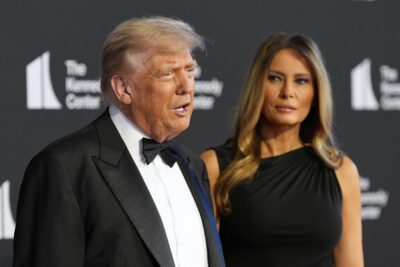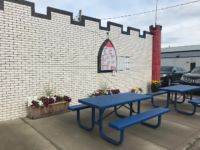Trump booed and cheered at the Kennedy Center while attending ‘Les Misérables’
By Canadian Press on June 11, 2025.

WASHINGTON (AP) — A tuxedo-wearing President Donald Trump was booed and cheered as he took his seat for the opening night of “Les Misérables” at the Kennedy Center, bringing his own dose of political drama to the theatrical production that was unfolding onstage.
It was his first time attending a show there since becoming president, reflecting his focus on remaking the institution in his image while asserting more control over the country’s cultural landscape.
“We want to bring it back, and we want to bring it back better than ever,” Trump said while walking down the red carpet with first lady Melania Trump. The Republican president has a particular affection for “Les Misérables,” the sprawling musical set in 19th-century France, and has occasionally played its songs at his events.
Opening night had a MAGA-does-Broadway feel. Ric Grenell, the Trump-appointed interim leader of the Kennedy Center, stood nearby as the president spoke to reporters. Attorney General Pam Bondi chatted with other guests. Health and Human Services Secretary Robert F. Kennedy Jr. took selfies with attendees. Vice President JD Vance and his wife, Usha, were also there.
There were more precautions than usual, given the guest list, and ticketholders had their bags searched after walking through magnetometers. Canned soda was on sale for $8, while a glass of wine cost $19.
Terry Gee, a bartender, bought his ticket for the show in November and didn’t mind Trump’s presence. It’s his sixth time seeing “Les Misérables,” and he said, “I’m going to enjoy the show regardless.”
Hannah Watkins, a nurse, only learned that Trump would be there when the Kennedy Center distributed information about extra security and she searched online to see what was happening.
“I’ve seen a lot of famous people so far, which is exciting,” said Watkins, who had claimed a spot near the VIP entrance with her mother. “Honestly, we just like ‘Les Mis’ and are excited to be here.”
Before Trump, presidential involvement in the Kennedy Center’s affairs had been limited to naming members to the board of trustees and attending the taping of its annual honors program in the fall.
But after returning to office in January, Trump stunned the arts world by firing the Kennedy Center’s longtime director and board and replacing them with loyalists, who then named him as chairman. Trump promised to overhaul its programming, management and even appearance as part of an effort to put his stamp on the national arts scene.
His latest moves have upset some of the center’s patrons and performers.
In March, the audience booed the Vances after they slipped into upper-level seats to hear the National Symphony Orchestra. Trump appointed Usha Vance to the Kennedy Center board along with Bondi, White House chief of staff Susie Wiles and Fox News Channel hosts Maria Bartiromo and Laura Ingraham, among other supporters.
Sales of subscription packages are said to have declined since Trump’s takeover, and several touring productions, including “Hamilton,” have canceled planned runs at the center. Actor Issa Rae and musician Rhiannon Giddens scrapped scheduled appearances, and Kennedy Center consultants including musician Ben Folds and singer Renée Fleming resigned.
Understudies may have performed in some roles Wednesday night because of boycotts by “Les Misérables” cast members, but Trump said he wasn’t bothered by anyone skipping the performance.
“I couldn’t care less,” he said.
Since returning to the White House in January, Trump has adopted a more aggressive posture toward the arts. The White House has taken steps to cancel millions of dollars in previously awarded federal humanities grants to arts and culture groups, and Trump’s budget blueprint proposed eliminating the National Endowment for the Arts and the National Endowment for the Humanities.
Trump has also targeted Smithsonian museums by signing executive orders to restrict their funding and by attempting to fire the director of the National Portrait Gallery.
Trump characterized previous programming at the Kennedy Center as “out of control with rampant political propaganda” and said it featured “some very inappropriate shows,” including a “Marxist anti-police performance” and “lesbian-only Shakespeare.”
The Kennedy Center, which is supported by government money and private donations, opened in 1971 and for decades has been seen as an apolitical celebration of the arts.
It was first conceived in the late 1950s during the administration of Republican President Dwight Eisenhower, who backed a bill from the Democratic-led Congress calling for a National Culture Center. In the early 1960s, Democratic President John F. Kennedy launched a fundraising initiative, and his successor, President Lyndon B. Johnson, signed into law a 1964 bill renaming the project the John F. Kennedy Memorial Center for the Performing Arts. Kennedy had been assassinated the year before.
___
Associated Press writers Mark Kennedy in New York and Chris Megerian in Washington contributed to this report.
Darlene Superville, The Associated Press
-25




